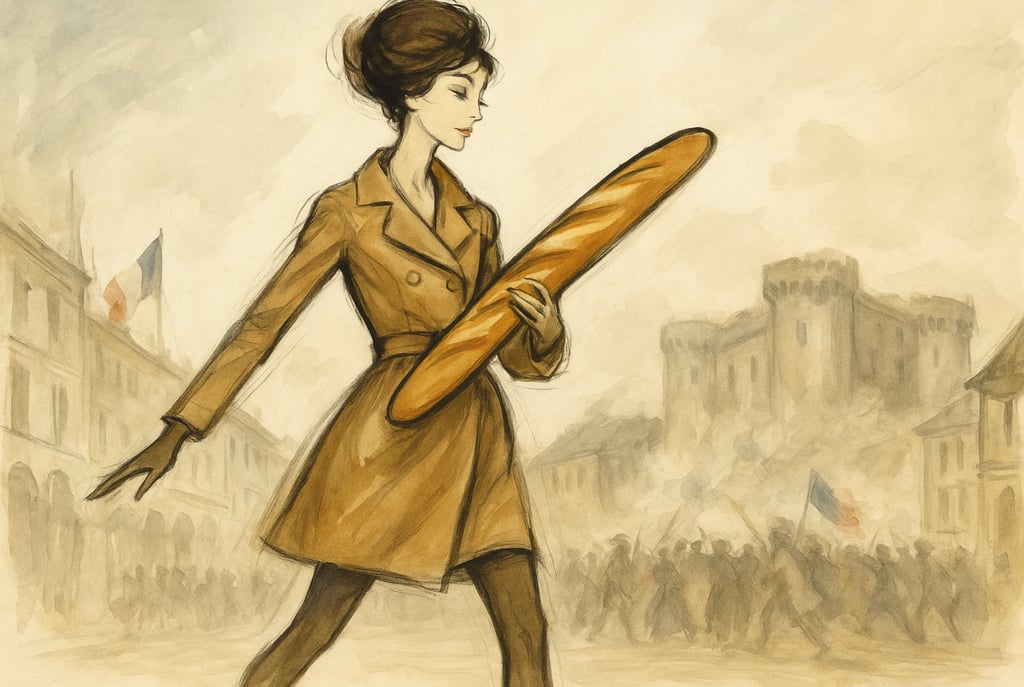Bastille Day and the Bread That Sparked a Revolution
Discover how bread shortages and riots fuelled the French Revolution, leading to the storming of the Bastille and turning hunger into a spark for liberty.
FOOD HISTORY & TRADITIONS


When we picture Bastille Day, we think of fireworks, waving flags, and triumphant cries of “Liberté, égalité, fraternité.” The storming of the Bastille on 14 July 1789 has become a symbol of freedom and rebellion, the day the French Revolution truly began. But beneath the banners and ideals, the Revolution was fuelled by something far simpler, far more primal: bread—or, more accurately, the lack of it.
In the summer of 1789, Paris was on edge, not just because of politics, but because of hunger. For the ordinary people of France, bread wasn’t a side dish. It was survival. And when the price of a loaf tripled, when queues for crumbs stretched for hours, when rumours swirled of hoarding and corruption, desperation gave way to rage. The Revolution wasn’t only born from ideas of democracy. It rose from empty stomachs.
The Daily Bread Crisis in Pre-Revolutionary France
For 18th-century labourers, bread accounted for up to three-quarters of their daily calories. A loaf wasn’t just food; it was life itself. When harvests failed in the years leading up to 1789, grain supplies dwindled. Prices soared, wages lagged, and taxes imposed by the monarchy and aristocracy piled onto the burden.
By July, the cost of bread had tripled, and riots began to spread across Paris and beyond. People looted bakeries and grain stores, not only out of hunger but out of fury. Rumours spread like wildfire: that bakers were hoarding grain to inflate prices, that corrupt officials were selling supplies to foreign markets, and that the monarchy was indifferent to the suffering of its people.
The tension was more than economic. Bread, as the staple food of the working class, symbolised a social contract. When people could not afford their daily bread, it wasn’t just their bellies that ached—it was their belief in the system. Starvation became a political act, and eating, or the inability to eat, became a revolutionary gesture.
Bread Riots and the Road to the Bastille
In the days before the storming of the Bastille, Paris was already in chaos. Hungry crowds gathered in marketplaces, demanding fair prices and storming carts carrying flour. Some seized control of bakeries, forcing them to distribute loaves for free or at pre-crisis prices. Others took over grain stores, redistributing sacks of flour in acts that blurred the line between riot and revolution.
On 12 July 1789, just two days before the Bastille fell, violent protests erupted in the streets. Buildings were looted, tax offices burned, and troops were called to restore order. But the unrest was far beyond control, and the cries were no longer just for bread—they were for justice, reform, and an end to a monarchy that let its people starve.
When the Bastille, a medieval fortress-prison, was stormed on 14 July, it was about more than freeing a handful of prisoners or seizing gunpowder. It was a symbolic blow against a system that had failed its people on the most basic level: the right to eat. Hunger gave the Revolution its urgency and its fury, pushing citizens to take the risk of open rebellion.
From Loaves to Liberty: The Revolution’s True Spark
While the Revolution would soon become about constitutions, guillotines, and sweeping political change, its early fuel was visceral. Hunger is a motivator more powerful than philosophy, and for the crowds in Paris, bread was freedom. The storming of the Bastille, as iconic as it became, was only one expression of the people’s outrage. Behind it lay a simpler cry: Give us food. Give us life.
Even the most famous myth of the Revolution—the infamous “Let them eat cake” line attributed to Marie Antoinette—captures this tension. Though historians agree she never said it, the phrase stuck because it reflected how the people saw the aristocracy: aloof, detached, and oblivious to the suffering below. Whether or not those words were ever uttered, they came to symbolise the anger of a populace that believed its rulers neither understood nor cared about the reality of survival.
Fun Fact: Bread as a Revolutionary Flashpoint
Bread riots weren’t isolated incidents; they had been building for years before 1789. One particularly telling moment came earlier that spring, when protesters in Paris seized grain shipments destined for army garrisons and redistributed them among the hungry. These “flour wars” showed that the issue wasn’t only scarcity—it was the perception that the monarchy and elites were hoarding food while ordinary people starved.
Bread was so central to the unrest that some Revolutionaries began using the phrase “pain et liberté” (“bread and liberty”) as a rallying cry, linking the right to eat with the right to political freedom. Even the guillotine, grim symbol of the Revolution’s later phase, was nicknamed “La Veuve” (“the widow”) in part because of the starving widows and families who had driven the uprising from the start.
Remembering Bastille Day Beyond the Fireworks
Today, Bastille Day is a celebration of freedom, resilience, and the birth of a new France. But beneath the patriotic parades lies a truth worth remembering: the Revolution wasn’t just about lofty ideals. It was about survival. It was about people pushed to the brink, for whom a loaf of bread was as revolutionary as a constitution.
So the next time 14 July rolls around and the sky lights up with fireworks, take a moment to picture Paris in 1789—not just the fortress falling, but the queues of exhausted families clutching coins, the anger in the markets, and the raw hunger that gave the Revolution its first spark. The fall of the Bastille may symbolise the dawn of liberty, but it was bread that truly ignited the flame.
